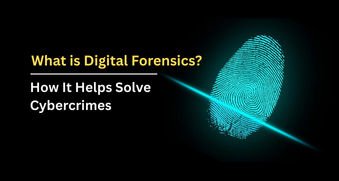What is Digital Forensics? How It Helps Solve Cybercrimes
Helping investigations on cybercrimes is one of the main approaches of digital forensics. Private entity exploits may include hacking, phishing, identity theft, even ransomware attacks. Expert forensic cyberspace detectives search hacked systems for hints on attack strategies and the perpetrators themselves.


Digital forensics, digital forensic science, is a particular field within forensic science that deals with the identification, recovery, analysis, and preservation of evidence from a digital electronic device. This field is crucial in the Cybercrime units and in support of both criminal and civil cases. As reliance on technology increases and more cyber threats arise, digital forensics becomes more important to law enforcement agencies, businesses, and cybersecurity specialists.
At its very essence, digital forensics is about ensuring the preservation of evidence throughout the investigation process through a number of steps and processes to facilitate its validity in court. The process often includes figuring out what is regarded as potential evidence, obtaining the data in a secure manner that does not compromise it, analyzing the evidence for useful information, and finally documenting the results for any legal investigative processes. Evidence in the form of documents, emails, and messages can be obtained from several sources such as Personal Computers, Mobile Devices, cloud services, IoT devices and even network logs.
Helping investigations on cybercrimes is one of the main approaches of digital forensics. Private entity exploits may include hacking, phishing, identity theft, even ransomware attacks. Expert forensic cyberspace detectives search hacked systems for hints on attack strategies and the perpetrators themselves.
For instance, reverse steganography and cross-drive analysis are forensic techniques that can extract hidden data or errors from several different devices. Also, digital forensics helps respond to breaches by lessening the impact of the damage and aiding in the restoration of operations for the organization.
Digital forensics is used outside the realm of cybercrime investigations. One example is the examination of a suspect's digital devices, which can yield evidence for fraud, theft, or violent crime. Similarly, in civil cases such as file deletion, intellectual property, or contractual conflict, analysis of metadata can be used to settle disputes.
A cross-border issue exists in the jurisdictional complexity of cases. The challenge of large volumes of data to decrypt adds to the problem file. AI (artificial intelligence) and machine learning, however, are being used in new digital forensic technologies to make forensic procedures for huge datasets more efficient.
As previously stated, defending against cybercrime is a critical reality today, and legal systems need digital forensics as much as it needs them. This area of research strengthens the cybersecurity posture of an organization and helps turn Investigations into Threat Intelligence by retrieving critical data to get the essence of the situation and not losing its integrity.
Why is Digital Forensics Important?
Digital forensic experts define cybercrime as a crime conducted through the use of devices such as computers, networks, and the internet. The criminals utilize these to cater to the exploitation of software, hardware, and behavioral vices for achieving malevolent goals, for instance, theft of data, financial fraud, identity theft, or unauthorized access to other systems. Cyber-criminals introduce intelligence methodologies that can wreak havoc on the operations of firms among all strata of society. Various techniques are used: phishing, malware, ransomware, and hacking strategies with the purpose of inflicting maximum damage. According to digital forensic experts, in cybercrimes, "digital fingerprints" are always left behind which are computer activities that can be traced through electronic devices or networks. These traces consist of metadata, logs, deleted files, IP addresses, etc., which could be forensically analyzed to reconstruct the sequence of events leading up to the crime. In sifting through these horrendous volumes of evidence, forensic investigators hope to reconstruct the method(s) by which the attackers breached or gained assistance in mugging, the origins, and the intention. Digital forensics is, on the one hand, a tool for tackling various crimes and prevention measures, and on the other hand, provides a wrap-off to dealing with data breaches themselves and ensures that security breaches do not happen in its extravagance. Digital forensics tools also help trace the origins of cybercrimes and protect against further exploitation. Forensic cyber security experts rely on these techniques to effectively prevent and address potential breaches. Digital forensics is more than just a one-sided shield to combat challenges thrown in by the groaning technical intricacies towards foreboding cyber threats.
How Digital Forensic Experts Describe Cyber Crime
Digital forensic experts define this concept as any criminal activity that involves using digital technology, such as computers, networks, or the internet, in the commission of the offenses. These programs usually use weaknesses in systems and software or exploit human behavior to abate certain damaging tasks, such as data theft, fraudulent financial transactions, identity theft, or obstructing services. Cybercriminals often use sophisticated techniques such as phishing, malware attacks, ransomware, and hacking to perpetrate their crimes. These crimes target the individual human, businesses, or governments making the scope and effect of such magnitude and far-reaching consequences. What makes the cybercrime arena particularly oppressive is its uninhibited nature. In contrast to a type of conventional crime that leaves some physical trails, cybercrimes have left behind "digital footprints." These are traces of action kept on electronic devices or networks. They might include traces of a phishing email in its metadata, system logs indicating unauthorized access, the existence of deleted files that could be raised back from the dead, and so forth for IP addresses that could be traced for establishing connections in a network pointing to some origins of the attack. Digital forensic experts investigate into and recover this trace of activity in order to recreate the events that took place before, during, and after the offense to reach a conclusion. In such a systematic way, they will eventually find out how the crime was committed, who did the deed, and the damage done. For instance, if the database of a company was breached, forensic investigators might determine whether it was caused by a phishing email or by a vulnerability in the system. They can also track down the perpetrator by analyzing network traffic patterns or tracing cryptocurrency transactions used for ransom payments. However, there is more to digital forensics than just solving crimes; it helps organizations and individuals understand their weaknesses to proactively prevent attacks in the future. By analyzing prior incidents, digital forensic investigations can reveal gaps in security and guide improvements to prevent future breaches.
Branches of Digital Forensics in Cyber Forensics
Computer Forensics in Forensic Cyber Security
- Computer forensics is one of the subdivisions of forensic science that concerns itself with the recovery and analysis of data from computer storage devices.
- Mobile device forensics involves extracting and analyzing evidence from smartphones, tablets, and GPS devices.
Network Forensics and Digital Forensics Tools
- Network forensics involves examining one or more packets in order to understand what kind of traffic, incident, or breach is happening, as well as to determine how to trace the actions of a hacker.
- Database forensics is concerned with looking for unauthorized access or modification of a database.
Mobile Device Forensics for Cyber Forensics Investigations
Memory forensics studies traditionally involve analyzing the information drawn from a computer system's volatile memory more specifically, the random access memory (RAM) to ascertain running processes or threats.
Database Forensics and Its Role in Digital Forensic Investigations
- Malware forensics is basically the independent study of malware so that the security experts can build an understanding of its function and impact.
- Digital image forensics provides the analysis of the authenticity of image files and detection of any manipulation or forgery of digital photographs, including digital signatures.
- Email forensics looks into the investigation( of) emails being conducted due to phishing, fraud, or cyber crime.
- IoT forensics searches for the evidence of IoT in order to help with the investigation. Cloud forensics investigates incidents of security breaches on cloud storage or other services.
- Digital video/audio forensics involve the analysis of some recordings to authenticate them or show tampering.
Steps in the Digital Forensics Process
Step 1: Collection How to Use Digital Forensics for Evidence
Step 2: Examination Digital Forensics Tools in Action
Step 3: Analysis Techniques Used by Digital Forensic Experts
Step 4: Reporting Presenting Findings in Cyber Forensics
The Frontline of Cyber Defense with Forensic Cyber Security
- Analyze how the attackers accessed the systems
- Identify the vulnerabilities that were exploited
- Trace the entry taken for accessing sensitive information
Investigation process involves:
- Analyzing system logs
- File recovery for deleted file
- Trace back to the source of malicious activities
- Patch weaknesses in any system
- Secure firewall configurations
- Strengthen intrusion detection systems.
- Development of incident response plans
- Stricter access controls to preempt activities from unauthorized persons.
This sets off a continuous loop such as:
- Investigating incidents
- Analyzing findings
- Following up with preventive measures
- Improving overall security posture


CATEGORIES
- Data Science and Analytics
- Cloud Computing
- Data Analytics and Business Intelligence
- AI and Digital Systems
- Cyber Security and Digital Forensics
- Business Analytics & Intelligence
- Banking & Financial Services
- International Business
- Digital Marketing
- Research Paper
- Media & Entertainment
- Media Management
- Journalism and Media Production
- Media & Information Technology
- Visual Communication
- Game Development
- Sound Engineering
- Game Art & Design
- Photography
- Film Making
- Animation & VFX
Are you aspiring to become a proficient Cyber Security and Digital Forensics professional?
Look no further; we are committed to nurturing the potential of young minds. Are you ready to enhance your skills?


